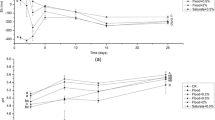Abstract
Soil water repellency in golf putting greens may induce preferential “finger flow”, leading to enhanced leaching of surface applied agrochemicals such as fungicides and nitrate. We examined the effects of root zone composition and the use of the non-ionic surfactant Revolution on soil water repellency, soil water content distributions, infiltration rates, turf quality, and fungicide and nitrate leaching from April 2007 to April 2008. The study was made on 4-year-old experimental green seeded with creeping bentgrass (Agrostis stolonifera L.) ‘Penn A-4’ at Landvik in southeast Norway. Eight lysimeters with two different root zone materials: (i) straight sand (1% gravel, 96% sand, 3% silt and clay, and 4 g kg−1 organic matter) (SS) and (ii) straight sand mixed with Sphagnum peat to an organic matter content of 25 g kg−1 (SP) were used in this study. Surfactant treatment reduced the spatial variability of water contents, increased infiltration rates and reduced water drop penetration times (WDPTs) by on average 99% in and just below the thatch layer. These effects were most evident for SS lysimeters. Surfactant treatment resulted on average in an 80% reduction of total fungicide leaching, presumably due to reduced preferential finger flow facilitated by decreased soil water repellency. Peat amendment reduced fungicide leaching by 90%, probably due to increased sorption of the fungicides to organic matter. Nitrate leaching was also smaller from surfactant-treated straight-sand root zones, but this effect was not significant.
Similar content being viewed by others
References
Cisar J.L., Williams K.E, Vivas H.E. & Haydu J.J. 2000. The occurrence and alleviation by surfactants of soil-water repellency on sand-based turfgrass systems. J. Hydrol. 231–232:352–358.
Council of the European Union 1997. Proposal for a council directive establishing annexe VI to directive 91/414/EEC concerning the placement of plant protection products on the market. Official J. Eur. Communities C240: 1–23.
Council of the European Union. 1998. Council Directive 98/83/ EC of 3 Nov. 1998 on the quality of water intended for human consumption. Official J. Eur. Comm. L330: 32–54.
Dekker L.W. & Ritsema C.J. 1994. How Water Moves in a Water Repellent Sandy Soil. 1. Potential and Actual Water Repellency. Water Resour. Res. 30: 2507–2517.
Dekker L.W., Ritsema C.J. & Oostindie K. 2004. Dry spots in golf courses: occurrence, amelioration and prevention. Acta Hort. 661: 99–104.
Doerr S.H., Shakesby R.A. & Walsh R.P.D. 2000. Soil water repellency: its causes, characteristics and hydro-geomorphological significance. Earth Sci. Rev. 51: 33–65.
Hendrickx J.M.H., Dekker L.W. & Boersma O.H. 1993. Unstable Wetting Fronts in Water-Repellent Field Soils. J. Environ. Qual. 22: 109–118.
Holen B. & Christiansen A. 2006. Handbook of analytical methods for pesticide residues. Norwegian Institute for Agricultural and Environmental Research, Bioforsk Laboratory, Ås, Norway.
Jarvis N.J. 2007. A review of non-equilibrium water flow and solute transport in soil macropores: principles, controlling factors and consequences for water quality. Eur. J. Soil Sci. 58: 523–546.
Kostka S.J. 2000. Amelioration of water repellency in highly managed soils and the enhancement of turfgrass performance through the systematic application of surfactants. J. Hydrol. 231/232: 359–368.
Kostka S.J., Schuermann G. & Franklin M. 2008. Alkyl-capped block copolymer surfactants for remediation of soil water repellency and heterogeneous rootzone moisture. pp. 69–76. In: Martin C. et al. (eds), Pesticide Formulations and Delivery Systems, 27th Volume: Traditional and Non-Traditional Developments.
Larsbo M., Aamlid T.S., Persson L. & Jarvis N. 2008. Fungicide leaching from golf greens: Effects of root zone composition and surfactant use. J. Environ. Qual. 37: 527–1535.
Ludvigsen G.H. & Lode O. 2008. Jord- og vannovervåkning i landbruket. Resultater fra overvåkning av pesticider i bekker og elver i Norge. Bioforsk Rapport 3(33): 1–38.
SAS Institute. 2002. SAS/STAT user’s guide. Version 9.1. SAS Inst., Cary, NC.
US Golf Association. 2004. Available at http://www.usga.org/turf/course_construction/green_articles/putting_green_guidelines.html (verified 6 Nov. 2007).
van Dam J.C., Hendrickx J.M.H., van Ommen H.C., Bannink M.H., van Genuchten M.T. & Dekker L.W. 1990. Water and solute movement in a coarse-textured water-repellent field soil. J. Hydrol. 120: 359–379.
Author information
Authors and Affiliations
Corresponding author
Additional information
The use of trade names in this paper does not imply endorsement of a product.
Rights and permissions
About this article
Cite this article
Aamlid, T.S., Larsbo, M. & Jarvis, N. Effects of surfactant use and peat amendment on leaching of fungicides and nitrate from golf greens. Biologia 64, 419–423 (2009). https://doi.org/10.2478/s11756-009-0094-7
Received:
Accepted:
Published:
Issue Date:
DOI: https://doi.org/10.2478/s11756-009-0094-7




